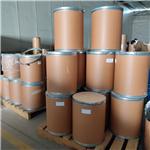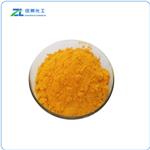Photoinitiator Role of Bis[2,6-difluoro-3-(1H-pyrrol-1-yl)phenyl]titanocene
Bis[2,6-difluoro-3-(1H-pyrrol-1-yl)phenyl]titanocene is an extremely reactive, orange colored solid photoinitiator for radical polymerisation of unsaturated resins upon exposure to visible light (daylight) or UV light. It is especially suited for the curing of photopolymers for imaging or information storage applications. Its self-color as well as its sensitivity to daylight and oxygen limits the use of IRGACURE 784 to specific applications. IRGACURE 784 may be used, after adequate testing, for UV and/or visible light curable formulations based on chemically unsaturated systems - such as those based on a prepolymer. Best curing performance of this product can only be achieved in the absence of oxygen. Its unique absorbance properties together with its outstanding reactivity make Bis[2,6-difluoro-3-(1H-pyrrol-1-yl)phenyl]titanocene especially suited for use in photopolymers, e.g. resists, printing plates and other information storage devices such as optical layers, holograms, laser direct imaging, stereolithography. Curing can be performed either using UV light, visible light (blue-green part of the spectrum) or even light from suitable laser devices. Ar-Laser (488nm) or FD-Nd/YAG-Laser (532nm). Best performance is obtained if oxygen is excluded from the resin system during curing. Applications in coatings, inks or adhesives may be of further interest. The amount of Bis[2,6-difluoro-3-(1H-pyrrol-1-yl)phenyl]titanocene required for optimum performance should be determined in trials covering a concentration range.
![Bis[2,6-difluoro-3-(1H-pyrrol-1-yl)phenyl]titanocene.png Article illustration](/NewsImg/2025-10-01/6389492380605058861645321.jpg)
Holographic Properties of Irgacure 784/PMMA Photopolymer
Holographic storage uses the interference principle of light to record information in the form of holograms on storage materials. The stored information can be retrieved by reconstructing holograms. Photopolymers incorporating poly-methyl methacrylate (PMMA) have emerged as a predominant choice in the burgeoning field of holographic storage, which is a focal point of contemporary research, attributed to their affordability, minimal shrinkage, ample storage capacity, adjustable thickness, and heightened stability and security. The information storage capacity of photopolymers is closely related to their holographic properties. Subsequent studies have been conducted to improve the solubility of the photosensitizer PQ by adding solvents such as BZMA and THFMA (up to 1.3wt% solubility), but the results were not substantial. In recent years, researchers have focused on a highly soluble photosensitizer, Bis[2,6-difluoro-3-(1H-pyrrol-1-yl)phenyl]titanocene, TI. Compared to the photosensitizer PQ, Irgacure 784 can reach a maximum solubility of 10wt% in MMA. It has been demonstrated that Irgacure 784/PMMA photopolymer materials perform better than PQ/PMMA photopolymer materials in terms of sensitivity, response time, and diffraction efficiency under the same experimental conditions. It is apparent that Bis[2,6-difluoro-3-(1H-pyrrol-1-yl)phenyl]titanocene holds promise as the favored photosensitizer for a new generation of photopolymer materials. Building upon existing research on the influence of doping with nanoparticles on photopolymer materials, we anticipate the diffraction efficiency of photopolymer materials will be improved by introducing nanoparticle components that amplify the refractive index modulation to the Irgacure 784/PMMA system. However, research in this area is currently rather limited. Therefore, we aim to provide new research directions and improve the holographic performance of photopolymer materials through our study.[1]
SiO2 nanoparticles with different concentrations were doped into Bis[2,6-difluoro-3-(1H-pyrrol-1-yl)phenyl]titanocene/PMMA photopolymer, and a 1.5 mm thick SiO2/Irgacure 784/PMMA photopolymer was prepared. By employing a mutual diffusion model, the concentration changes in different components within the photopolymer material during the exposure process were numerically simulated. This study provides evidence that the introduction of SiO2 nanoparticles enables the formation of a steady-state refractive index modulation within the photopolymer. Furthermore, during the diffusion process, the presence of SiO2 nanoparticles induces the influx of a greater number of photosensitizer molecules into the illuminated region, leading to increased consumption and subsequent generation of photoproducts. Ultimately, this approach facilitates the anticipated increase in the degree of refractive index modulation in the photopolymer. The results of our experiments indicate that holographic properties are improved when the Bis[2,6-difluoro-3-(1H-pyrrol-1-yl)phenyl]titanocene/PMMA photopolymer is doped with SiO2 nanoparticles. Further investigation is recommended to determine the effectiveness of doping with other nanoparticles, and this study can be used as a reference for enhancing holographic properties using the polymer system studied.
References
[1]Wang J, Fu Q, Zhang Y, Zhang B. Holographic Properties of Irgacure 784/PMMA Photopolymer Doped with SiO2 Nanoparticles. Polymers (Basel). 2023 Nov 13;15(22):4391. doi: 10.3390/polym15224391. PMID: 38006115; PMCID: PMC10674833.
You may like
Related articles And Qustion
See also
Lastest Price from Bis[2,6-difluoro-3-(1H-pyrrol-1-yl)phenyl]titanocene manufacturers

US $30.00-10.00/KG2025-04-15
- CAS:
- 125051-32-3
- Min. Order:
- 50KG
- Purity:
- 99%
- Supply Ability:
- 500000kg

US $10.00/kg2025-04-15
- CAS:
- 125051-32-3
- Min. Order:
- 1kg
- Purity:
- 99%
- Supply Ability:
- 20ton
![125051-32-3 Bis[2,6-difluoro-3-(1H-pyrrol-1-yl)phenyl]titanocenenanoparticleindex modulation](https://www.chemicalbook.com/CAS/GIF/125051-32-3.gif)